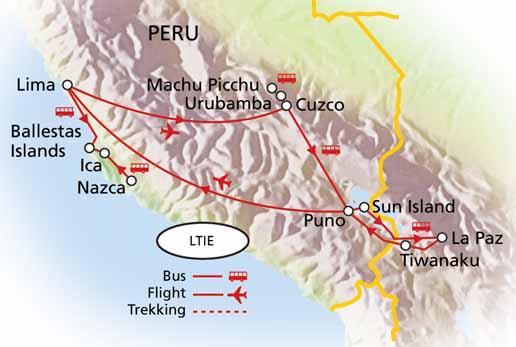

The Nazca Lines were first discovered by outsiders when commercial airlines began flying across the Peruvian desert in the 1920's. Passengers reported seeing 'primitive landing strips' on the ground below. Today people sometimes fly in hot air balloons to view the splendors of the Nazca Lines.
The Nazca Lines were allegedly made by removing the iron-oxide coated pebbles which cover the surface of the desert. When the gravel is removed, they contrast with the light color underneath. In this way the lines were drawn as furrows of a lighter color. Off the Pampa, south of the Nazca Lines, archaeologists have uncovered what they believe is the Lost City of the line-builders, Cahuachi - built nearly 2,000 years ago and mysteriously abandoned 500 years later.
Were the original designs created by ancient aliens for purposes unknown today?
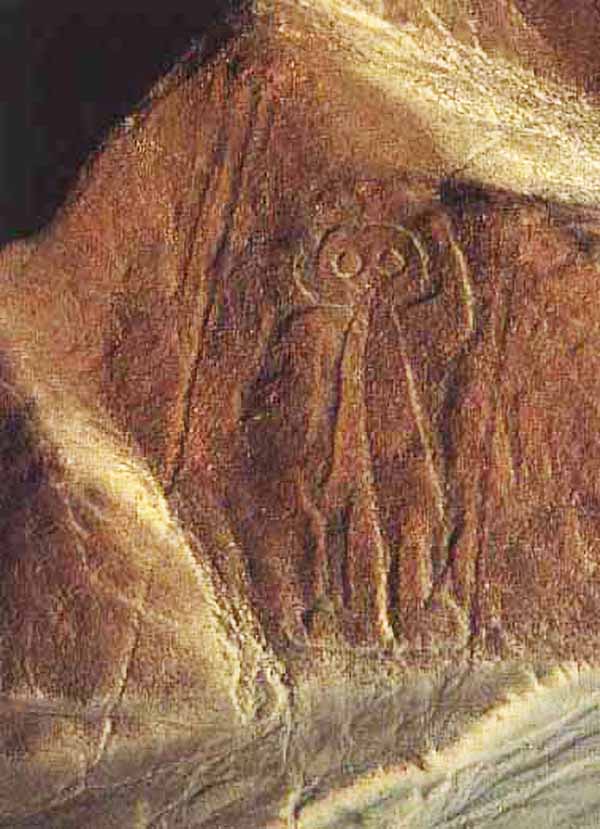
The Nazca Lines appear to tell a story carved in stone - which begs the questions - created by who and for what purpose? Looking at the Nazca Lines from above it is hard to imagine that the Inca created them without guidance from extraterrestrials.
I believe it was the simulation of reality that created the Nazca Lines, Crop Circles, and other enigmatic formations connected to unexplained mysteries and storylines that we play out in linear time in the human biogenetic experiment. Reality is about asking questions while never really having the whole picture unless you are programmed to understand simulation theory - creation by design based on physics and math.
The Nazca Lines are a group of very large geoglyphs found the Nazca Desert in southern Peru. As new formations are continually discovered - it further emphasizes the fact that they are all consciousness inserts in the simulation. Ex.: One day nothing is there ... the next day new lines (formations) appears as if out of nowhere.
'Knife-wielding orca' and alien-looking figures among 300 Nazca Lines discovered in groundbreaking AI study Live Science - September 24, 2024
The Nazca Lines allegedly were created between 500 BC and AD 500 by people making depressions or shallow incisions in the desert floor, removing pebbles and leaving differently colored dirt exposed. In recent years between hundreds of new figures had been found with the use of drones, and archaeologists believe that there are more to be found.
Most lines run straight across the landscape, but there are also figurative designs of animals and plants. The individual figurative geoglyph designs measure between 400 and 1,100 metres (440-1,200 yd) across. The combined length of all the lines is over 1,300 km (800 mi), and the group covers an area of about 50 km2 (19 sq mi). The lines are typically 10 to 15 cm (4-6 in) deep. They were made by removing the top layer of reddish-brown iron oxide-coated pebbles to reveal a yellow-grey subsoil. The width of the lines varies considerably, but over half are slightly over 33 cm (13 in) wide. In some places they may be only 30 cm (12 in) wide, and in others reach 1.8 m (6 ft) wide.
Some of the Nazca lines form shapes that are best seen from the air (at around 500 m [1,600 ft]), though they are also visible from the surrounding foothills and other high places. The shapes are usually made from one continuous line. The largest ones are about 370 m (400 yd) long. Because of its isolation and the dry, windless, stable climate of the plateau, the lines have mostly been preserved naturally. Extremely rare changes in weather may temporarily alter the general designs. As of 2012, the lines are said to have been deteriorating because of an influx of squatters inhabiting the lands.
The figures vary in complexity. Hundreds are simple lines and geometric shapes; more than 70 are zoomorphic designs, including a hummingbird, spider, fish, condor, heron, monkey, lizard, dog, cat, and a human. Other shapes include trees and flowers. Scholars differ in interpreting the purpose of the designs, but in general, they ascribe religious significance to them. They were designated in 1994 as a UNESCO World Heritage Site.
Stretching across the Nazca plains like a giant map or blueprint left by ancient astronauts, lie the famous Nazca Lines of Peru. Peru is associated with the Inca Civilization.
The Nazca Lines span a vast swath of the rugged Peruvian desert and remain an engima. No one has proof as to who built them and what their function was. Since their discovery, the they have inspired fantastic explanations from ancient gods, a landing strip for returning aliens, a celestial calendar created by the ancient Nazca civilization - putting the creation of the lines between 200 BC and 600 AD, used for rituals probably related to astronomy, to confirm the ayllus or clans who made up the population and to determine through ritual their economic functions held up by reciprocity and redistribution, or a map of underground water supplies.
There are huge geoglyphs in Egypt, Malta, United States (Mississippi and California), Chile, Bolivia and other countries, but the Nazca geoglyphs, because of their numbers, characteristics, dimensions and cultural continuity, were made and remade throughout the whole pre-hispanic period, forming a most impressive, as well as enigmatic, archeological group.
The Nazca Lines are located in the Nazca Desert, a high arid plateau that stretches between the towns of Nazca and Palpa on the pampa (a large flat area of southern Peru). The desolate plain of the Peruvian coast which comprises the Pampas of San Jose (Jumana), Socos, El Ingenio and others in the province of Nasca, is 400 Km. South of Lima, covers an area of approximately 450 km2, of sandy desert as well as the slopes of the contours of the Andes. They cover nearly 400 square miles of desert. Etched in the surface of the desert pampa sand about 300 hundred figures made of straight lines, geometric shapes most clearly visible from the air.
The Nazca plain is virtually unique for its ability to preserve the markings upon it, due to the combination of the climate (one of the driest on Earth, with only twenty minutes of rainfall per year) and the flat, stony ground which minimizes the effect of the wind at ground level. With no dust or sand to cover the plain, and little rain or wind to erode it, lines drawn here tend to stay drawn. These factors, combined with the existence of a lighter-colored subsoil beneath the desert crust, provide a vast writing pad that is ideally suited to the artist who wants to leave his mark for eternity.
The pebbles which cover the surface of the desert contain ferrous oxide. The exposure of centuries has given them a dark patina. When the gravel is removed, they contrast with the color underneath. In this way the lines were drawn as furrows of a lighter color, even though in some cases they became prints. In other cases, the stones defining the lines and drawings form small lateral humps of different sizes. Some drawings, especially the early ones, were made by removing the stones and gravel from their contours and in this way the figures stood out in high relief. The concentration and juxtaposition of the lines and drawings leave no doubt that they required intensive long-term labor as is demonstrated by the stylistic continuity of the designs, which clearly correspond to the different stages of cultural changes.
There appear to be various designs consisting of figures of animals, flowers and plants, objects, and anthropomorphic figures of colossal proportions made with well-defined lines. An example of this is the drawing of a weird being with two enormous hands, one normal and the other with only four fingers. Also represented are drawings of man-made objects such as yarn, looms and "tupus" (ornamental clasps). All these figures have well-defined entrances which could be used as paths or to allow people to line together along the conformations of the drawings. The anthropomorphic figures are relatively few and are situated on the slopes.
The lines are many kilometers long and crisscross sectors of the pampas in all directions. Many of the lines form geometric figures: angles, triangles, bunches, spirals, rectangles, wavy lines, concentric circles.
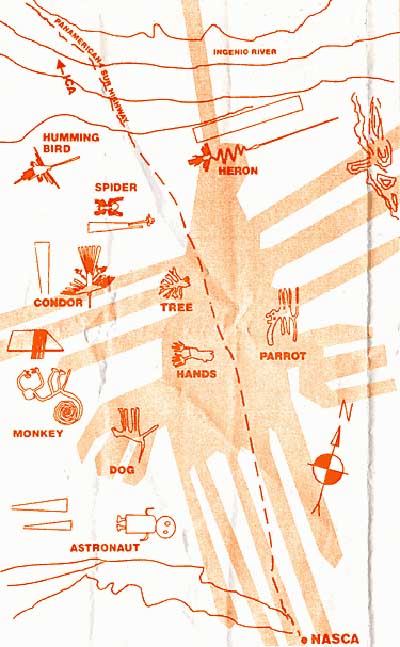
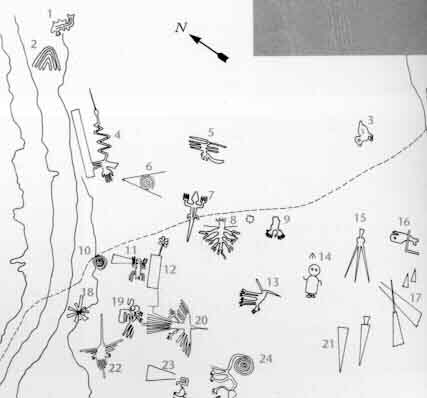



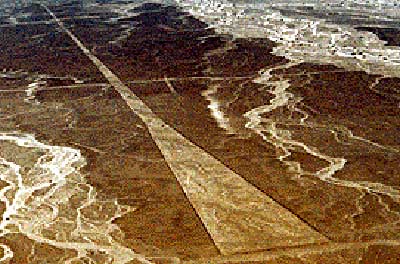
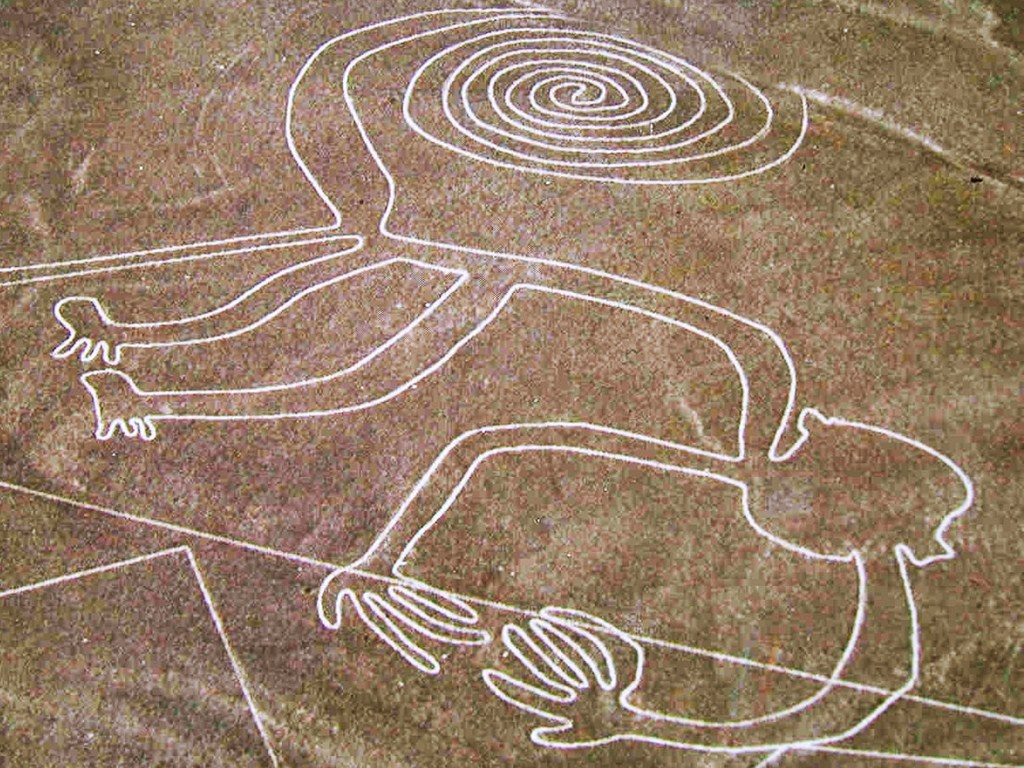
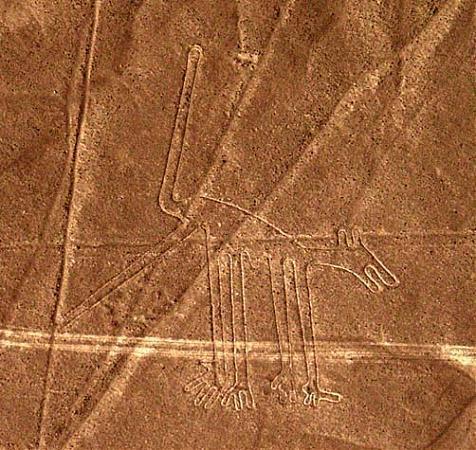
Birds - (Ascension of Consciousness)
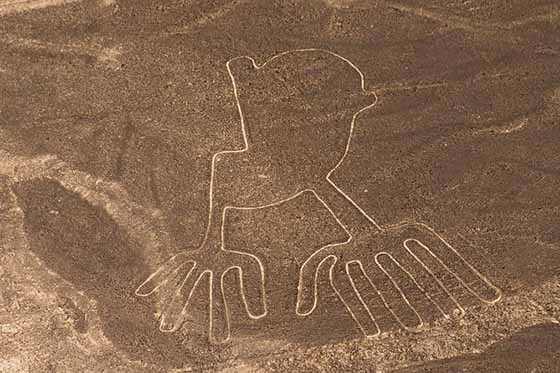

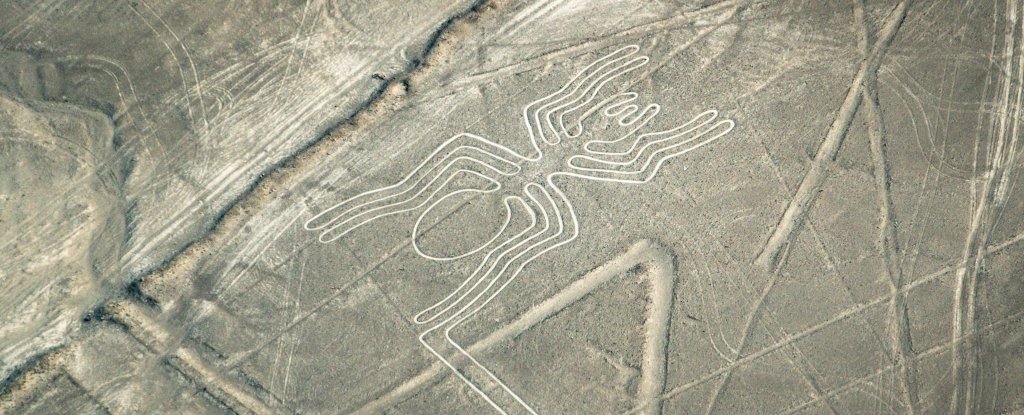
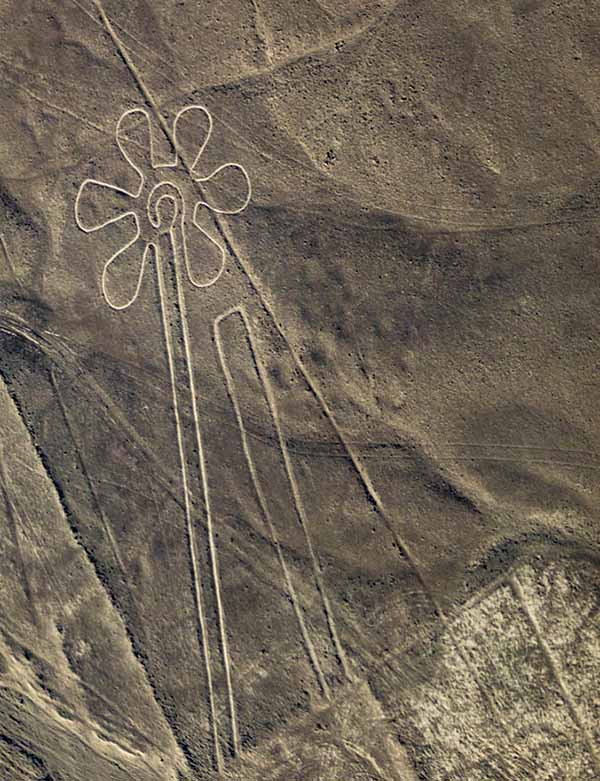
It is difficult to keep the Nazca Lines free from outside intervention. As with all ancient ruins, such as Machu Piccu, weather by wind and rain, and human tampering will take their toll on these ancient Lines.
In recent years the Nazca Lines have suffered gradual destruction, as tomb raiders seeking pre-Inca artifacts scar the terrain with hundreds of burrows, garbage, among other waste material. A boom in copper and gold mining - including a mine built in 1997 a few feet from a 2,000-year-old, two-mile-long trapezoid -- is defacing parts of the Nazca Lines with tracks from truck traffic.
Over the past decade, advertisers and political campaigns have carved huge messages in the rock and sand between the ancient designs in this region 250 miles south of Lima.
In 1998, floods and mudslides from the El Nino weather pattern seriously eroded several figures.
As electricity reaches the growing local population, utility companies are running power cables over and around the site.
The damage to the Lines underscores Peru's desperate struggle to preserve its national patrimony. Archaeologists say they are watching helplessly as the quest for scholarship and conservation in a country viewed as the cradle of New World civilization is losing out to commercial interests, bleak poverty and the growing popularity of heritage sites as tourist attractions.
Toribio Mejia Xespe, a Peruvian doctor and anthropologist was the first scientist, in 1927, to show interest in what he called "great Incan ceremonial artifacts".
Erich von Daniken suggested, in his 1968 book, Chariots of the Gods, that the lines were built by ancient astronauts as a landing strip. But the soft clay soil and layer of brown and black rocks in the Nazca desert would seem an unsuitable site for landing and were blown away by the power of rocket propulsion. The aliens left - never to return - leaving the people confused. Like in the modern cargo cults they tried to call the Gods back by drawing lines, figures and trapezes.
Robin Edgar believed that the Nazca Figures were inspired by, and intended to be seen by, the (so-called) Eye of God that is manifested during total solar eclipses. An extraordinary series of solar eclipses coincided with the construction of the Nasca lines. Some Lines are aligned with the winter solstice, a less spectacular but more regular, death and rebirth of the Sun God.
Michael Coe believes the Nazca Lines are sacred paths to walk by specific rites. The primary lines were an offering for elders, heaven, and mountain deities who gave them water for their fields.
The Code of Carl Munck - The Ancient Geomatria of Numbers - The Nazca Line ground markings locate themselves on The Code Matrix system. Nazca Lines and Archaeocryptography The ancient sites around the world are very precisely positioned on a global coordinate system in relation to the position of the Great Pyramid at Giza. The positions of the sites are given in the geometry of their construction. A very ancient system of numbers was used in the system, which we will call Gematria. Gematrian numbers are found in ancient myths and religions, including the Bible. Gematrian numbers were used in systems of weights and measures by ancient peoples, including the Greeks, the Egyptians, the Persians, the Babylonians and the Romans. The Code system uses mathematical constants, such as pi and the radian. The system also uses conventions that are still in use, such as the 360 degree circle, 60 minute degree, 60 second minute, the base-ten numbering system, the 12-inch foot, and the 5280-foot mile.
The ancient Mayans used Gematrian numbers in their very accurate timekeeping.
Maria Reiche was a German mathematician and archaeologist who was famous for researching the Nazca Lines. She believed the lines were an Astronomical Calendar indicating the direction of the rising of important stars and planetary events like sun solstices. Formations like the spider and the monkey could show star constellations like Orion and Ursa Mayor. The problem with all astronomical theories is the unknowing of the age. The direction of stars changes within centuries, explained by the precession of the equinoxes.
Reiche led a determined effort to discredit theories of extraterrestrial visitors. She argued that the Nazca Indians constructed the Lines some time between 300 BC and AD 800. In support of this possibility, some scientists have put forward ingenious ideas on how the geoglyphs could theoretically have been designed from the ground. The more important evidence, however, is that which attempts to link the Lines definitively to the Nazcan culture. Here, neither of the two key pieces of evidence survive close scrutiny.
The first piece of evidence is a series of radiocarbon dates, based on ceramic and wood remains which were left at the Lines by the Nazca people. It is claimed that this proves that the Nazcans constructed the Lines. On the contrary, the dating of these materials tells us only that the Nazcans lived in the area of the Nazca Lines. Since the Lines themselves cannot be radiocarbon dated, the possibility remains that they already existed when the Nazcan culture emerged. The second piece of evidence is the alleged resemblance of the Nazca geoglyphs to certain features found on Nazca pottery. This is an important issue because it potentially offers proof that the Nazcans had either designed the images or at least viewed them from the air. Maria Reiche died in 1998 at the age of 95. She is buried in the arid valley she loved so well.
Professor Gerald Hawkins and his group went to Nazca to prove the astronomical Theory of Maria Reiche but was unsuccessful. In 1968, a study by the National Geographic Society determined that, while some of the Nazca lines did point to the positions of the Sun, Moon and certain stars two thousand years ago, it was no more than could be expected by mere chance. In 1973, Dr Gerald Hawkins studied 186 lines with a computer program and found that only 20 per cent had any astronomical orientation - again no more than by pure chance.
Simone Waisbard stated that the drawing of Nazca are a giant astronomical calendar. Further the Nazca-line-system was used to measure the precipitation value. Figures, especially seabirds, have a connection to the meteorological prophecy system of the Nazca-Culture. Her ideas for the trapezoid formations: places for holy animals before sacrifice them, or field claims connected with filter galleries, observatories or places for ritual ceremonies of the different clans.
Alan F. Alford concluded that the Nazca-Lines was made by Negroid Slaves of the Tihuanaco Culture. After a revolution the Negroid population destroyed some figure, this is the explanation for overdrawn zigzag-formations. Later this people went in northern direction and founded Chavin and the Olmec culture.
Robert Bast linked the lines to the Flood Stories in his book A Memory of the Deluge. The animal, plant and human-shaped figures are lying together on the ground as a memorial place of the big flood.
Gilbert de Jong wrote A Nazcan Zodiac. He traveled to Nazca and measured the GGF by GPS. He obtained a length of the square side of about 54,7 Meter. In the formation he recognized a Zodiac.
Markus Reindel's Dowsing Theory says that the Nazca Figures are markers for a subterranean waterflow. Trapezoides show the broadness of the waterstream, zigzaglines show where they end, lines show into direction of the puquitos. He explain the nature of the figures by rod-dowsing (to find the subterranean water) and shamanstic flights (to overview the figures).
Scientists Discover 168 Mysterious Nazca Geoglyphs in The Desert Sands of Peru Science Alert - December 13, 2022
Drone surveys and aerial images in southern Peru have now identified 168 new geoglyphs in the Nazca Lines World Heritage Site, with roughly 50 of these large-scale geographical drawings depicting human-like figures. One of the humanoid illustrations even appears to be sporting a bit of facial hair, Homer Simpson-style. The Nazca desert in Peru is like an art gallery for the gods above. Yet even with decades of surveillance from the skies, we've barely explored a small wing of this fading collection of giants among the stones.
Scientists Uncover Gorgeous 2,000-Year-Old Etching of a Giant Cat in Nazca Desert Science Alert - October 20, 2020
A cat lies in the Sun in Peru, its ears up and alert, its belly exposed, and tail stretched out. The cat is 37 metres (120 feet) long, and around 2,000 years old. It's a geoglyph recently discovered in the famous Nazca desert in Peru. Last year, an archaeologist in Peru told The Guardian he thought scientists had found only 5 percent of all the Nazca lines out there in the desert. Researchers at Yamagata University in Japan are now working with local archaeologists to change that, and their latest haul of ancient lines nearly doubles the previous number of known designs. In all likelihood, there are still many more ancient artworks hiding out there in the desert.
Over 140 New Nazca Lines Have Been Discovered, And We Finally Have Clues to Their Use Science Alert - November 19, 2019
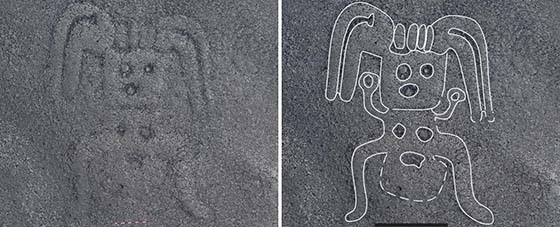
Scientists have discovered over 140 new geoglyphs known as Nazca lines: a mysterious, ancient cluster of giant figures etched long ago into the desert terrain of southern Peru. Archaeologists report that a long-term research effort conducted since 2004 has uncovered 143 previously unknown Nazca geoglyphs - with one carved figure, which had eluded human detection, being discovered by artificial intelligence. In all, the newly identified geoglyphs are thought to have been created between at least 100 BCE and 300 CE. While the purpose of these large motifs drawn by the ancient Nazca culture remains debated, we do at least know how they were constructed.
The Nazca lines contain more than 2,700 geometric shapes, lines and images of plants and animals etched into the sand. Daily Mail - June 20, 2019
Identifications of the specific animals drawn had relied on general impressions.
Experts compared the details of the avian figures with the features of real birds.
They found that the birds that they re-identified did not live in the Nazca region.
Better identifications may help experts work out why the figures were made.
Ancient Humanoid-Shaped Nazca Line Discovered in Peruvian Desert Live Science - November 19, 2019
A sprawling humanoid-shaped character etched into the Peruvian desert has just been discovered by a team of scientists using artificial intelligence. The geoglyph is one of hundreds of diverse shapes carved into a swath of Peru and called the Nazca Lines. The newly found Nazca Line is about 13.1 feet (4 meters) long and 6.6 feet (2 m) wide. It appears to depict a human-like individual with a rectangular head who is holding a stick and wearing a headdress, said scientists from Yamagata University and IBM who discovered the etching.
The Nazca lines contain more than 2,700 geometric shapes, lines and images of plants and animals etched into the sand. Daily Mail - June 20, 2019
Mysterious Etchings in Peruvian Desert Prove to Be Foreign Birds. What Did They Mean to the Pre-Incans? Live Science - June 20, 2019
The sprawling Nazca Lines have long been cloaked in mystery. The enormous geoglyphs number in the thousands and portray everything from animals and plants to seemingly mythical beasts and geometric patterns. Now, researchers have found some of Peru's massive creations depict non-native birds. Among the 16 massive bird carvings in the Nazca desert of southern Peru are a hermit (a forest species) and a pelican (a coastal denizen). No one knows why the Nazca Lines were made, and it's too early to say why the pre-Inca people who carved them would have been interested in non-native birds.
Drone survey reveals dozens of previously undiscovered Nazca Lines depicting warriors and animals carved into Peru's landscape 1,800 years ago Daily Mail - April 7, 2018

Archaeologists have discovered more than 50 mysterious new 'Nazca lines' in Peru, which were constructed nearly 2,000 years ago by ancient inhabitants who painstakingly arranged pebbles into massive shapes. Some are hundreds of years older than the most famous Nazca lines previously discovered. The researchers learned that while some of the geoglyphs were produced by Nazca people, others date back to a time before they lived in the region where the drawings can be found. The Nazca people lived in the area from 200 to 700 CE. Some of the designs are believed to be created instead by the Topara and Paracas people.
Truck driver plows into Peru's 2,000-year-old archeological enigma CNN - February 1, 2018
Peru's world renowned Nazca Lines were damaged when a rig plowed into the ancient site on Saturday, the country's ministry of culture said. Jainer Jesus Flores Vigo, 40, was arrested after he allegedly ignored warning signage and drove over UNESCO World Heritage site, the ministry said. Flores Vigo was released Monday after a magistrate said there was not enough evidence to prove that he had acted with intent.
Ring-Shaped Geoglyphs Found Near Ancient Town in Peru Live Science - September 23, 2016
Dozens of circular geoglyphs, some comprising several intertwined rings, have been identified and mapped near the ancient Peruvian town of Quilcapampa, revealing that these earthen designs were created near ancient pathways used for trade. Geoglyphs are designs, which often form shapes or images, on the landscape. They are found all over the world; the most famous examples are located at Nazca, where thousands of such designs - from real and imaginary creatures to geometric shapes - have been etched into the Peruvian desert. The newly mapped geoglyphs may have had symbolic significance, possibly representing the flow of people and goods through the town at the time.
New geoglyphs found in Nazca desert after sandstorm PhysOrg - August 8, 2014
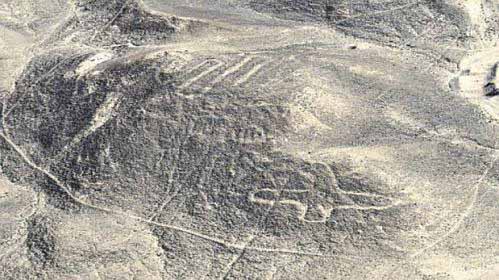
The newly revealed figures discovered by de la Torre are of a snake (approximately 196 feet in length), a bird, a camelid (perhaps a llama) and some zig-zag lines. They are actually on some hills in the El Ingenio Valley and Pampas de Jumana near the desert floor. Archeologists have been alerted to authenticate the find.
Mysterious Nazca Lines Desert Drawings Form Labyrinth Live Science - December 27, 2012
Some of the Nazca Lines, mysterious geoglyphs that span a vast swath of the rugged Peruvian desert, may have once been a labyrinth with a spiritual purpose, a new study suggests. At the time the Nazca Lines, which span 85 square miles (220 square kilometers), were drawn, people were not looking at this stuff from the air, they were looking at stuff from the ground level. To appreciate what they might have meant to ordinary people, then you have to walk them.
Logging 'caused Nazca collapse' BBC - November 2, 2009
The ancient Nazca people of Peru are famous for the lines they drew in the desert depicting strange animal forms. A further mystery is what happened to this once great civilization, which suddenly vanished 1,500 years ago. Now a team of archaeologists have found the demise of the Nazca society was linked in part to the fate of a tree. Analyzing plant remains they reveal how the destruction of forests containing the huarango tree crossed a tipping point, causing ecological collapse.
Forest clearances sealed ancient civilization's downfall PhysOrg - November 2, 2009
Archaeologists examining the remains of the Nasca, who once flourished in the valleys of south coastal Peru, have uncovered a sequence of human-induced events which led to their "catastrophic" collapse around 500 AD. The Nasca are probably best known for the famous "Nazca Lines", giant geoglyphs which they left etched into the surface of the vast, empty desert plain that lies between the Peruvian towns of Nazca and Palpa.
On the pampa, south of the Nazca Lines, archaeologists have now uncovered the lost city of the line-builders, Cahuachi. It was built nearly two thousand years ago and was mysteriously abandoned 500 years later. New discoveries at Cahuachi are at last beginning to give us insight into the Nazca people and to unravel the mystery of the Nasca Lines.
In general, Nazca culture is considered to consist of three stages; Early, Middle, and Late stages, and also the Classic Nazca (approximately A.D. 250-750). One of the most famous and distinctive features of the Nazca culture is the polychrome pottery which has attracted attention because of its technological refinement and the exciting symbolism of its motifs. This pottery culture spreads in the area of the valleys of Chincha, Pisco, Ica, Nazca and Acari.
In the Early stage, these wares did not have much color, but Middle and Late Nazca polychromes are buff or red and are painted in three to eight colors. The most popular choices of color were red, black, white, brown, yellow, gray and violet with an outline in black. Bowls and beakers were common forms, but double-spout and head-and-spout jars are also found. Birds, fish or fruits were commonly drawn on the pottery, and Nazca's religious or mythological features were also used in its design.
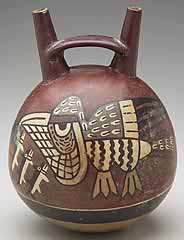

Nazca Figurine depicts a Solar Eclipse and the Eye of Creation
Cahuachi was a major ceremonial center of the Nazca culture and overlooked some of the Nazca lines from 1 CE to about 500 CE. Italian archaeologist Giuseppe Orefici has been excavating the site for the past few decades, bringing a team down every year. The site contains over 40 mounds topped with adobe structures.
The permanent population was quite small, but it was apparently a pilgrimage center that grew greatly in population for major ceremonial events. These events probably involved the Nazca lines and the giant sand dune of Nazca. Support for the pilgrimage theory comes from archaeological evidence of sparse population at Cahuachi and from the Nazca lines themselves which show creatures such as killer whales and monkeys which were not present in the Nazca region. Trade or travel may explain the images. Due to the dry climate the finds are quite rich and include even such ephemeral material as clothing. Looting is the greatest problem facing the site today.
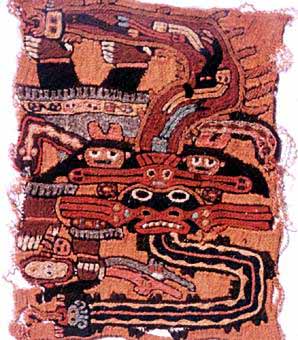
Their ancient technique of weaving, that the Nazca people developed, has given an insight into how the lines may have been made, and what they might have been used for more than 1,500 years ago.
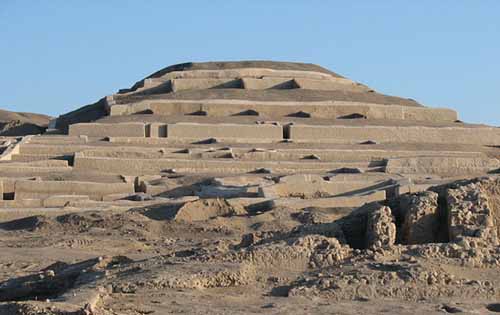
Cahuachi, in Peru, was a major ceremonial center of the Nazca culture and overlooked some of the Nazca lines from 1 CE to about 500 CE. Italian archaeologist Giuseppe Orefici has been excavating the site for the past few decades, bringing a team down every year. The site contains over 40 mounds topped with adobe structures. It has also been studied by Helaine Silverman, who has written a book on Cahuachi.
The permanent population was quite small, but it was apparently a pilgrimage center that grew greatly in population for major ceremonial events. These events probably involved the Nazca lines and the giant sand dune of Nazca. Support for the pilgrimage theory comes from archaeological evidence of sparse population at Cahuachi and from the Nazca lines themselves which show creatures such as orca and monkeys which were not present in the Nazca region. Of course, trade or travel may explain the images. Due to the dry climate the finds are quite rich and include even such ephemeral material as clothing.
Looting is the greatest problem facing the site today. Most of the burial sites surrounding Cahuachi were not known until recently and so present a very tempting target.
Stunningly preserved in the dry soil of the Peruvian desert
are the mummified bodies of the Nazca people themselves.